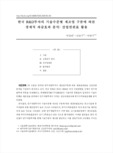

-
 * 본 문서는 배포용으로 복사 및 편집이 불가합니다.
* 본 문서는 배포용으로 복사 및 편집이 불가합니다.
미리보기
서지정보
· 발행기관 : 기술경영경제학회
· 수록지 정보 : 기술혁신연구 / 26권 / 1호
· 저자명 : 박창대, 안승구, 박중구
목차
Ⅰ. 서론
Ⅱ. 선행연구 분석
Ⅲ. 연구방법론
Ⅳ. 분석결과
Ⅴ. 결론초록
본 논문은 한국의 연구개발투자가 제조업구분에 따른 파급효과들을 산업연관분석을 이용하여 분석하고 있다. 연구 방법은 2010∼2014년 국내 산업연관표 상에서 연구개발투자 부문을 외생화하고, 경제협력개발기구(OECD)의 기술수준 분류표에 입각하여 기술수준별로 제조업을 분류하여 연구개발투자가 미치는 생산유발효과와 부가가치유발효과를 분석하였다. 분석결과, 연구개발투자의 기술수준별 제조업 구분에 따른 생산유발효과는 중고기술과 중저기술에 속한 제조업에서 높은 것으로 나타났으며, 부가가치유발효과 역시 중고기술 제조업에서 높은 것으로 나타났다. 반면 연구개발투자가 가장 많은 고기술제조업에서 생산유발효과와 부가가치유발효과가 상기 2부문보다 낮은 것으로 분석되었다. 이러한 결과들은 한국 제조업이 연구개발투자를 통해 기술수준의 제고를 달성하고 이를 산업구조의 고도화로 이어간다는 품질사다리론과 연계되지 않았음을 의미한다. 이러한 분석결과로부터 한국의 연구개발투자가 고기술제조업의 생산유발과 부가가치효과의 증대를 위해 구조조정이 필요하다는 시사점을 얻었다. 본 논문은 산업연관표의 구조적 특성으로 인해 연구개발투자의 시차를 고려하지 못한 한계를 안고 있다.영어초록
This study analyzes the economic impacts of Korean R&D expenditure on the industrial structure by technological levels using 2010∼2014 Input-Output table data. The industrial structure is reclassified into 4 manufacturing industries by OECD’s Technology Intensity Definition. Then, we analyzes the production-inducing and value added–inducing of those industries. As the results of the analysis, it is found that the production-inducing effect by the R&D expenditure has been higher in the middle-high and middle-low technology manufacturing and that the value added-inducing effect has been higher in the middle-high technology manufacturing. On the other hand, the production and value added-inducing effects has been lower in the high-tech manufacturing which is highest in the R&D expenditure. The above results indicate that industrial structure has not been linked with the quality ladder that expresses the enhancement of tech level through R&D expenditure. Based on these results, the policy recommendation implies that R&D expenditure should be concentrated to improve the production- and value-added effects of the high technology manufacturing in order to advance the industrial structure. However, this study has the limitation that the analyses on the dynamic-inducing effects are not carried out due to the lack of fixed capital formation data.참고자료
· 없음태그
-
자료후기
-
자주묻는질문의 답변을 확인해 주세요

꼭 알아주세요
-
본 학술논문은 (주)코리아스칼라와 각 학회간에 저작권계약이 체결된 것으로 AgentSoft가 제공 하고 있습니다.
본 저작물을 불법적으로 이용시는 법적인 제재가 가해질 수 있습니다. -
해피캠퍼스는 구매자와 판매자 모두가 만족하는 서비스가 되도록 노력하고 있으며, 아래의 4가지 자료환불 조건을 꼭 확인해주시기 바랍니다.
파일오류 중복자료 저작권 없음 설명과 실제 내용 불일치 파일의 다운로드가 제대로 되지 않거나 파일형식에 맞는 프로그램으로 정상 작동하지 않는 경우 다른 자료와 70% 이상 내용이 일치하는 경우 (중복임을 확인할 수 있는 근거 필요함) 인터넷의 다른 사이트, 연구기관, 학교, 서적 등의 자료를 도용한 경우 자료의 설명과 실제 자료의 내용이 일치하지 않는 경우
“기술혁신연구”의 다른 논문도 확인해 보세요!
-
대학 교원 창업 활성화 방안 연구: 이해충돌 규정을 중심으로 25 페이지
대학 교원 창업은 기술 이해도가 높은 고급인력의 기술창업으로 일반적인 기회형 창업보다 성장성 및 파급효과가 높은 양질의 창업 유형이다. 이러한 장점에 주목하여 정부는 대학 교원 창업 활성화를 위한 노력을 지속해오고 있다. 그러나 현행 법규 및 관련 제도는 교원 창업에 대한 명확한 정의뿐만 아니라 교원 창업과 관련한 주체들(대학, 교수, 대학원생 등)간 이해.. -
소셜미디어 분석을 활용한 재난안전산업 육성정책 수립방안 27 페이지
다양하게 변화하는 재난양태와 기후변화로 인한 빈번한 재난발생뿐 아니라 생활수준 향상 등의 이유로 재난안전에 대한 국민적 관심이 증대되고 있다. 이와 연계하여 재난안전 산업에 대한 요구도 증가하고 있다. 그 동안 다양한 재난안전산업 육성 및 활성화 정책이 수립되었지만, 국가주도의 정책이 대부분이었고, 민간분야와 국민관심도가 반영된 정책은 부재한 상황이다. 따.. -
과학기술행정체제 및 혁신 거버넌스 연구의 현황과 과제 30 페이지
본 연구는 과학기술행정체제와 혁신 거버넌스 연구의 큰 변화 흐름을 살펴보고, 성찰적 자리매김을 통해 향후 나아가야 할 방향을 제시하였다. 분석 대상은 「한국행정학회보」, 「한국정책학회보」 등의 행정학·조직학 분야와 「과학기술학연구」, 「기술혁신연구」, 「기술혁신학회지」 등의 과학기술혁신 분야에 실린 과학기술행정체제 및 혁신 거버넌스 관련 논문을 중심으로 살..
문서 초안을 생성해주는 EasyAI

